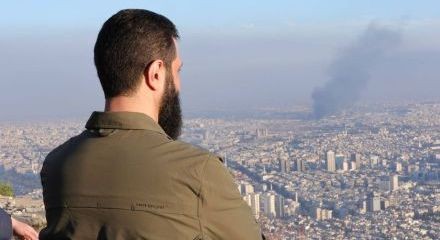24.07.2025

Fragmenting Syria
Israel’s intervention in Syria to protect the Druze minority is part of an ambitious geostrategic plan to redraw borders and extend its influence to the Euphrates and into Iraq, says Yassamine Mather
We have witnessed a deadly resurgence of violence in southern Syria, particularly in the Druze-majority province of Suwayda. With over 1,000 killed and more than 128,000 displaced within weeks, the conflict highlights the region’s volatile geopolitics, involving Israel, Turkey, Kurdish actors and a weakened Syrian government.
Historically autonomous and politically cautious, Syria’s Druze community remained relatively insulated throughout the Syrian civil war. However, in July 2025, tensions erupted between local Druze militias and Sunni Bedouin groups. The Damascus government responded with a heavy-handed crackdown, prompting allegations of indiscriminate shelling, arbitrary detentions and human rights abuses. Far from restoring order, the intervention has alienated Druze communities, intensifying demands for protection and autonomy.
Israel responded by launching airstrikes on Syrian military targets near Suwayda city. Prime minister Benjamin Netanyahu claimed these were ‘humanitarian interventions’ to protect the Druze, while, of course, critics, including within the US administration, condemned them as destabilising and opportunistic.
The attacks coincided with mounting speculation around Israel’s proposed David’s Corridor - not infrastructure, like China’s Belt and Road project, more a military route and a joining together of potential, regional proxies such as the Kurds and Druze. This ‘peripheral alliance’ strategy would extend Israel’s influence from its newly acquired Golan buffer zone through to Suwayda in the south and all the way to the Euphrates and the Kurdish-held regions in north-east Syria. Something, if it were achieved, which would facilitate intervention in Iraq’s already fractious politics. Israeli advocates frame the corridor as protection for minorities and enhanced security logistics. In reality it is a blueprint for a Greater Israel and permanently fragmenting Syria. Note, the non-binding Knesset 71:13 vote to annex the West Bank. Gaza will, of course, be next.
Turkey has positioned itself as both mediator and antagonist. Ankara facilitated a temporary ceasefire after Israeli strikes on Damascus and held talks with Druze leaders. President Recep Tayyip Erdoğan, however, denounced Israel’s actions as expansionist, warning that any corridor strengthening Kurdish autonomy near Turkey’s southern border would be unacceptable. Turkey’s stance reflects its broader regional strategy: to block Kurdish independence, assert regional leadership and limit both Israeli and Iranian influence.
There is little mention of the other party to this conflict: Syria’s Bedouins. They are traditionally nomadic or semi-nomadic Arab tribes, primarily inhabiting the steppe and desert regions (Badia) of central and southern Syria, including areas around Homs, Hama, Palmyra and extending towards the Jordanian and Iraqi borders. Organised into powerful, kinship-based tribes (eg, Fadl, Hadidiyin, Bani Khaled, Mawali), they are led by sheikhs. Historically they rely on herding (camels, sheep, goats) and seasonal migration; for pasture and water. However, many have settled due to urbanisation, drought and state policies, though tribal identity remains strong. Culturally, they emphasise values like hospitality, courage, tribal honour and independence. They adhere to Sunni Islam and have historically acted as guides, transporters and sometimes military auxiliaries due to their desert expertise, playing complex roles in modern Syrian politics and the ongoing conflict.
Competition
Conflict between Bedouin tribes and the Druze occurred primarily in the 19th and early-to-mid 20th centuries, driven by several factors. Land and water were at the core though: Bedouins needed seasonal grazing lands and water sources on the plains and foothills surrounding Jabal al-Druze, the Druze mountain. Meanwhile Druze farmers needed the self-same water sources, plains and foothills for settled agriculture (wheat, olive groves, orchids, etc).
Bedouin pastoralism (especially during droughts) sometimes involved grazing on Druze lands or raiding villages for supplies - viewed by Druze as theft and trespassing, and leading to armed defence and retaliation.
During the Ottoman era, the authorities often played groups off against each other, sometimes employing Bedouin tribes (like the Fadl) to assert control or collect taxes from the independent Druze tribes. This turned Bedouins into instruments of state pressure against the Druze, who guarded their mountain autonomy jealously. Powerful Bedouin confederations controlling surrounding plains were seen as a threat to this autonomy, as well as barriers to trade routes. Ambitious tribal sheikhs and Druze leaders sometimes sought to expand influence or settle scores through warfare.
Historically, cycles of raiding and retaliation have created deep-seated mistrust and vendettas, which flared up over minor incidents. Key historical clashes include numerous 19th century clashes, often involving major Bedouin confederations (like the Fadl under Sheikh Diab) and Druze forces defending their periphery. The Battle of al-Kafr (1910) was a major, bloody engagement, where Druze forces decisively defeated a large Bedouin (Fadl tribe) army attempting to penetrate Jabal al‑Druze, significantly curtailing Bedouin influence in core Druze areas for decades.
During the French mandate (1920-46), both groups participated in revolts (eg, the ‘Great Syrian Revolt’, 1925-27), but tensions and occasional clashes persisted, sometimes manipulated by French ‘divide and rule’ tactics. Post-independence tensions decreased significantly under the centralising Ba’athist state (from 1963), which suppressed tribal/sectarian autonomy, disarmed populations, imposed authority and implemented economic changes reducing direct competition.
However, severe droughts before and during the Syrian civil war increased competition for scarce water and grazing. While drawn into different sides of the conflict, direct, sustained Bedouin-Druze fighting was not a major feature until 2025, with the Druze focused on defending their heartland and Bedouins involved across central/eastern Syria.
The transitional Syrian government under president Ahmed al-Sharaa, nominally supported by both the US and Russia, is clearly part of the problem due to its own connections with Jihadi groups and inability to control sectarian violence in the south. Suwayda now represents a flash point for different visions of Syria’s future: centralised governance versus autonomy; national unity versus ethnic fragmentation. The fate of the Druze community may become a bellwether for whether Syria descends further into partition or finds a path to inclusive political resolution.
Much has been written about Druze leader Hikmat al-Hijri and his role. Born in 1965 in Venezuela to a Druze religious family, al‑Hijri returned to Syria for religious training, eventually assuming spiritual leadership over Syria’s Druze. Raised conservatively, he became the ‘Sheikh al-Aql’ (the community’s highest authority) in 2012. Like many clerics under the Ba’ath regime, al-Hijri initially avoided overt politics, focusing on spiritual and social affairs. However, escalating violence in Syria, including Islamic State attacks on Suwayda, gradually drew him into national debates.
He began openly criticising the Assad regime’s failure to defend Druze areas and he advocated autonomy in Suwayda. He rejected forced conscription of Druze men into Assad’s army (causing significant losses) and resisted incursions by foreign militias and government forces into Druze territory. Under his influence, Druze militias gained de facto control of local security. While many rallied around him, some accused al‑Hijri of authoritarian tendencies and insufficient commitment to democratic reforms.
A turning point came in 2021 with a reportedly insulting phone call by a Syrian army general, sparking mass protests, which were violently suppressed by the regime’s forces. Al-Hijri’s relationship with Damascus deteriorated sharply. Though he initially praised Bashar al-Assad in 2012 as “the hope of the nation”, he later opposed the Syrian dictator. However, he is no fan of the current Damascus government led by the Hayat Tahrir al-Sham, denouncing its actions as extremist and likening its atrocities to IS crimes.
In a notable break from Syrian political orthodoxy, al-Hijri told The Washington Post that Israel is “not an enemy”, criticising decades of anti-Israel rhetoric he believes did nothing for ordinary Syrians. His call for international intervention to protect civilians further estranged him from both the regime and various opposition factions.
Al-Hijri’s position remains contested within the Druze hierarchy. Contrasting his statements, two other ‘Sheikh al-Aqls’, Hammoud Hannawi and Yusuf al-Jarboua, released a joint statement emphasising loyalty to Syria’s unity and rejecting secessionist rhetoric. This reflects an internal divide - between those demanding autonomy/neutrality in Syria’s fragmented landscape and those committed to a united Syrian nation.
Kurdish territory
The proposed David’s Corridor has serious implications for Syrian Kurds. Here a general comment is necessary regarding the Kurdistan Workers Party (PKK) and its affiliates. Criticism of the PKK and its Syrian allies has never centred on their armed struggle or on giving up arms, but rather their lack of strategy and constant pragmatism, bordering on opportunism. They have aligned themselves with various reactionary states, depending on momentary requirements - at times with Iran’s Islamic Republic against Turkey, or with the US against Assad and jihadists.
Concerning Israel’s David’s Corridor, the Kurdish People’s Protection Units (YPG) and their broader umbrella group, the Syrian Democratic Forces (SDF), have become (either willing or unintentional) actors in any plan involving north-eastern Syria - especially the David’s Corridor. Originating from the PYD (Democratic Union Party), the Syrian offshoot of the PKK, the YPG rapidly gained territory early in the Syrian civil war. Becoming the USA’s main ground partner in the anti-IS campaign, particularly during the Siege of Kobane (2014-15), the YPG/SDF benefited from US and allied airstrikes, aid and weapon drops.
This support enabled the YPG to consolidate control over oil-rich, strategically vital areas east of the Euphrates. Despite ongoing tensions with the Assad regime, tactical coordination occurred post-2019 to resist Turkish incursions. The US maintains a limited military presence and continues funding the SDF, while France and other EU actors offer mild political backing.
The David’s Corridor - though officially unconfirmed - would create a logistical arc bypassing Iranian-controlled areas, facilitating energy trade, intelligence-sharing and potential military positioning.
Would the YPG entertain cooperation? The answer is probably yes. It has consistently prioritised strategic survival. Israeli support could enhance Kurdish leverage against Turkey and Damascus. However, an overt partnership carries significant risks: Arab SDF members might resist, and the alliance would likely provoke a backlash from Iran, Hezbollah and the Syrian regime. Russia and even the US may disapprove of an open Israeli alignment.
Given Israel’s historic support for Kurdish autonomy as a wedge against rival states, cooperation remains plausible - but would likely be indirect or covert. Should the David’s Corridor progress, the YPG/SDF might calculate that discreet cooperation serves their goals, provided it does not jeopardise internal cohesion or external alliances.
Fall of Assad
Bashar al-Assad’s eventual fall was, in many ways, good news. For over a decade, his regime had been synonymous with brutal repression, sectarian war and mass displacement. His removal ended one of the most violent chapters in Syria’s modern history. However, for those who saw this moment as the dawn of a new Arab Spring - a resurgence of democratic, grassroots uprisings - this hope was quickly dashed.
The reality is that Assad’s fall did not result from popular mobilisation or a democratic uprising, but from cynical regional power politics. The actors driving regime change - notably Turkey and the United Arab Emirates - are themselves authoritarian regimes with no interest in fostering genuine democracy in Syria or the region.
Turkey’s role has been driven by imperial nostalgia and domestic politics. Erdoğan’s government used the Syrian war to extend influence across northern Syria, render hopeless Kurdish armed resistance and perhaps secure a new electoral partner.
The UAE represents the counterrevolutionary camp’s opposite pole: an authoritarian monarchy obsessed with stamping out political Islam and popular revolt. Its involvement in Syria is aimed at balancing Iranian influence, supporting authoritarian stability and containing any revolutionary spillover threatening the Gulf monarchies. The UAE’s ‘stability’ means rule by the iron fist without any meaningful popular participation.
In this context, regime change becomes a mechanism for replacing one form of authoritarian rule with another - tailored to regional powers’ interests, not Syrians’ needs. It is a reshuffling of elites, not a dismantling of repression.
Therefore Assad’s downfall has not transformed conditions for genuine revolutionary forces from below - those capable of resisting both domestic tyranny and foreign manipulation.
